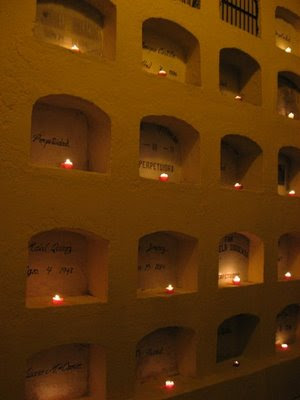Last night, I visited several cemeteries as part of a guided Day of the Dead tour. At the General Cemetary in the heart of Oaxaca, the whole thing had the feel of a carnival, complete with street vendors selling food, hot drinks, toys, and even games of chance. Very few families actually decorate or sit at the graves in the center of this urban cemetery. Rather, it’s more of an opportunity for community groups to build altars as a kind of outreach. I saw one honoring the victims of domestic violence, and another hailing the “death of fashion” and honoring those who had struggled with bulimia or anorexia. There was also a general ofrenda built in the center, and candles in all the niches around the walls of the cemetery.

The cemetery is very old (at least by U.S. standards), and victims of various epidemics in the 1800’s were buried here. The wall around the cemetery is full of niches where people are buried. Some niches have been cleared of their anonymous contents to make room for new folks.
The anonymous ones seem to say "perpetuidad" - and I loved the ones below - one died in 1887, the other in 1997. Yet, it almost seems like the same handwriting . . .
We also went to two cemeteries further out in a smaller, more rural town. The Xoxo cemeteries (a shortened and more pronounceable name for the town using only the first four letters, and pronounced “ho-ho”) were a bit closer to the traditions I’d read about. Though still packed with tourists (like me!) and food vendors, families had gone all out decorating the grave sites, and many families were hanging out around the graves, sipping a cerveza while the kids set off fireworks nearby. Even grave sites without families obviously in attendance were cleaned and decorated with flowers and candles.
Based on what I’ve seen and read, the more urban the area is, the more of a party and a spectacle it is, complete with guided tourists and professional tri-pod carrying photographers and Mexican teenagers wearing scanty costumes and altars as political activism and opportunities to win a few pesos by hitting balloons with a dart. The more rural the area, the more likely it is that families will come together and honor the heart of the tradition, building altars to close family members and sitting graveside. And of course, that also means it is less likely (and less appropriate) for tourists and outsiders like me to see it. And this makes sense: a tourist might be able to go to a school Christmas pageant with a guide, but would never simply walk into a stranger’s house on Christmas morning.
I’m glad to have seen some of the pageant.
Saturday, November 1, 2008
A Tourist in the Graveyard
Posted by
Bridget
at
10:20 AM
![]()
![]()
Labels: Day of the Dead, Travel
Subscribe to:
Post Comments (Atom)











No comments:
Post a Comment